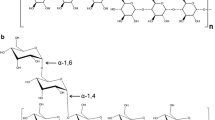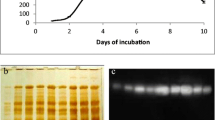Abstract
Tropical isolates of Aureobasidium pullulans previously isolated from distinct habitats in Thailand were characterized for their capacities to produce the valuable polysaccharide, pullulan. A. pullulans strain NRM2, the so-called “color variant” strain, was the best producer, yielding 25.1 g pullulan l−1 after 7 days in sucrose medium with peptone as the nitrogen source. Pullulan from strain NRM2 was less pigmented than those from the other strains and was remarkably pure after a simple ethanol precipitation. The molecular weight of pullulan from all cultures dramatically decreased after 3 days growth, as analyzed by high performance size exclusion chromatography. Alpha-amylase with apparent activity against pullulan was expressed constitutively in sucrose-grown cultures and induced in starch-grown cultures. When the alpha-amylase inhibitor acarbose was added to the culture medium, pullulan of slightly higher molecular weight was obtained from late cultures, supporting the notion that alpha-amylase plays a role in the reduction of the molecular weight of pullulan during the production phase.


Similar content being viewed by others
References
Badr-Eldin SM, El-Tayeb OM, Ei-Masry HG, Mohamad FHA, El Rhman OAA (1994) Polysaccharide production by Aureobasidium pullulans: factors affecting polysaccharide formation. World J Microbiol Biotechnol 10:423–426
Catley BJ (1970) Pullulan, a relationship between molecular weight and fine structure. FEBS Lett 10:190–193
Cooke WB (1959) An ecological life history of Aureobasidium pullulans (de Bary) Arnaud. Mycopathol Mycol Appl 17:1–43
Deshpande MS, Rale VB, Lynch JM (1992) Aureobasidium pullulans in applied microbiology: a status report. Enzyme Microbial Technol 14:514–527
Federici F (1982) Extracellular enzymatic activities in Aureobasidium pullulans. Mycologia 74:738–743
Gorin PA (1981) Carbon-13 nuclear magnetic resonance spectroscopy of polysaccharides. Adv Carb Chem Biochem 38:13–97
Leal-Serrano G, Ruperez P, Leal JA (1980) Acidic polysaccharide from Aureobasidium pullulans. Trans Br Mycol Soc 75:57–62
Leathers TD (1993) Substrate regulation and specificity of amylases from Aureobasidium strain NRRL Y-12,974. FEMS Microbiol Lett 110:217–222
Leathers TD (2002) Pullulan. In: Vandamme EJ, De Baets S, Steinbuchel A (eds) Biopolymers. Polysaccharides II: polysaccharides from eukaryotes, vol 6. pp 1–35. Wiley-VCH, Weinheim
Leathers TD (2003) Biotechnological production and applications of pullulan. Appl Microbiol Biotechnol 62:468–473
Leathers TD, Nofsinger GW, Kurtzman CP, Bothast RJ (1988) Pullulan production by color variants of Aureobasidium pullulans. J Ind Microbiol 3:231–239
Linardi VR, Machado KMG (1990) Production of amylase by yeasts. Can J Microbiol 36:751–753
Miura Y, Irie T, Fujio Y, Ueda S (1978) Effect of amylase inhibitor on pullulan production. Hakkokogaku 56:136–138
Nelson N (1944) A photometric adaptation of the Somogyi method for the determination of glucose. J Biol Chem 153:375–380
Prasongsuk S, Sullivan RF, Kuhirun M, Eveleigh DE, Punnapayak H (2005) Thailand habitats as sources of pullulan-producing strains of Aureobasidium pullulans. World J Microbiol Biotechnol 21:393–398
Punnapayak H, Sudhadham M, Prasongsuk S, Pichayangkura S (2003) Characterization of Aureobasidium pullulans isolated from airborne spores in Thailand. J Ind Microbiol Biotechnol 30:89–94
Reed-Hamer B, West TP (1994) Effects of complex nitrogen sources on pullulan production relative to carbon source. Microbios 80:83–90
Saha BC, Silman RW, Bothast RJ (1993) Amylolytic enzymes produced by a color variant strain of Aureobasidium pullulans. Cur Microbiol 26:267–273
Strumeyer DH (1967) A modified starch for use in amylase assays. Anal Biochem 19:61–71
Wickerham LJ, Kurtzman CP (1975) Synergistic color variants of Aureobasidium pullulans. Mycologia 67:342–361
Acknowledgments
The authors gratefully thank the Royal Golden Jubilee PhD program (Grant number 4.S.CU/42 Q.1) of the Thailand Research Fund, Ratchadaphiseksomphot Endowment Fund and Eveleigh-Fenton Fund (Rutgers University) for the financial support. Expert technical contributions were made by Melinda Nunnally and James Nicholson of the National Center for Agricultural Utilization Research, ARS, USDA, Peoria, IL.
Author information
Authors and Affiliations
Corresponding author
Additional information
Names are necessary to report factually on available data; however, the USDA neither guarantees nor warrants the standard of the product, and the use of the name by the USDA implies no approval of the product to the exclusion of others that may also be suitable.
Rights and permissions
About this article
Cite this article
Prasongsuk, S., Berhow, M.A., Dunlap, C.A. et al. Pullulan production by tropical isolates of Aureobasidium pullulans . J Ind Microbiol Biotechnol 34, 55–61 (2007). https://doi.org/10.1007/s10295-006-0163-7
Received:
Accepted:
Published:
Issue Date:
DOI: https://doi.org/10.1007/s10295-006-0163-7




